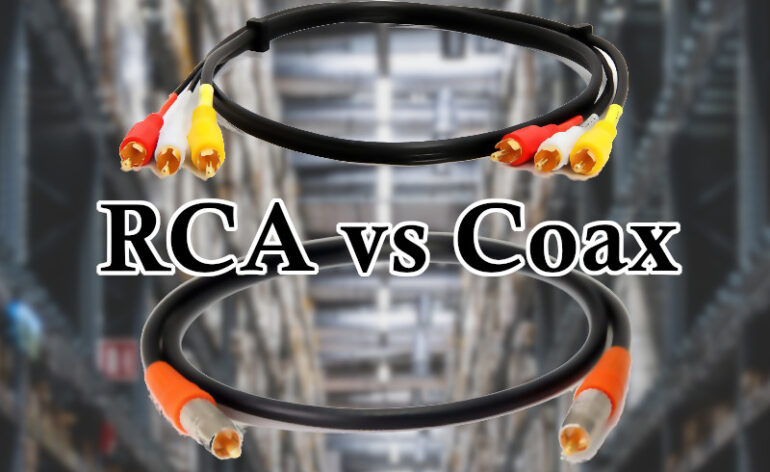RCA and Digital Coax Cables – What’s the Difference?
Just because two things look the same doesn’t mean that they are the same. You don’t have to be on this earth for very long to figure that out. Some snakes are very venomous and dangerous and other snakes look like them just for protection. In home theater, there are two cables that look identical. RCA cables and digital coax cables have seemingly no differences. They have the same connectors, the cable bodies look the same, and they are often sold under both names. But are there any real differences? Let’s discuss!
Back in My Day…
Let’s roll back the clock to the heady days of the 1990’s and 2000’s when AV receivers were really starting to catch on, everybody still had a VCR somewhere in the home, and DVD players were on the way. When you bought a VCR or (later) a DVD player, you’d get a set of cables that looked like this:

Now, it may not be immediately obvious to you, but if you look closely, the yellow cable (for video) is slightly thicker than the red and white cables (used for audio). That will become important in a minute.
Differences Between RCA and Digital Coax Cables
To begin with, let’s talk terminology. RCA is a style of connector. It is the thing at the end of the cable that plugs into your devices. What most people call RCA cables and Digital Coax cables both have RCA connectors at the end. Coax is the type of cable between the two RCA connectors.
The important difference between an RCA cable and a Digital Coax cable is shielding. Look again at the RCA cables above. The yellow cable is thicker than the red and white cables. This is because the yellow cable carried the video signal. The video signal was much more susceptible to outside interference (namely electromagnetic interference and radio frequency interference). Therefore, the yellow cable had better shielding. Digital Coax cables have better shielding than RCA cables.
There are other differences as well. Because of the shielding, Digital Coax cables tend to be thicker and less pliable. RCA cables are less expensive but also are more delicate (can suffer internal damage more readily). Digital Coax cables also have a constant impedance of 75 ohms while an RCA cable can have around 50 ohms impedance.
Should I Use a Digital Coax Cable or RCA?
Digital Coax cables can be used for any RCA cable application. Remember that yellow cable above? When Digital Coax cables were first released, we used to recommend people use that yellow cable for their Digital Coax connection. These days, if you look up “RCA cable” online at nearly any retailer, you are likely going to be looking at a Digital Coax cable that will work well for both applications. Since Digital Coax cables are backward compatible with any RCA connection, it makes sense to sell the thicker version.
Of course, since the only substantive difference between RCA and Digital Coax cables is the shielding, you could use the RCA cable for your digital connection. It might work. Because of the lack of shielding, the RCA cable is going to be more likely to have issues from interference. Especially if you are running a long cable. We’d always recommend buying Digital Coax cables. They aren’t that much more expensive and offer better protections.



Any shielded coax cable will work. If you have old cable TV cables around. You can use F-connector-to-RCA or just snip off the F-connectors and cut the cable to your desired length and crimp on RCA male ends.
Absolutely true.